Nongenomic responses to 17beta-estradiol in male rat mesenteric arteries abolish intrinsic gender differences in vascular responses
- PMID: 16231002
- PMCID: PMC1751239
- DOI: 10.1038/sj.bjp.0706422
Nongenomic responses to 17beta-estradiol in male rat mesenteric arteries abolish intrinsic gender differences in vascular responses
Abstract
The aim of the present study was to investigate the gender differences in the acute effects of 17beta-estradiol on the rat superior mesenteric artery. Isometric tension was measured in rings of mesenteric arteries from both male and female Sprague-Dawley rats. Relaxation to acetylcholine was not significantly different between arteries (with endothelium) from male and female rats in the absence or presence of 17beta-estradiol. After blockade of endothelium-dependent hyperpolarizations with apamin (0.3 microM) plus charybdotoxin (0.1 microM), acute exposure to 17beta-estradiol (1 nM) for 30 min resulted in enhancement of relaxation to acetylcholine in arteries from male but not female rats. After acute exposure to 17beta-estradiol, mesenteric arteries from male rats were more sensitive to sodium nitroprusside than arteries from female rats. Contractions of mesenteric arteries to phenylephrine and 9,11-dideoxy-11alpha,9alpha-epoxymethanoprostaglandin F(2alpha) (U46619) were greater in arteries from male rats than female rats. This difference was not detected after acute exposure to 17beta-estradiol. In preparations without endothelium, the enhancement of relaxation and reduction in contraction in arteries from male rats were preserved. These results suggest that there exists a gender difference in the response to the acute nongenomic modulatory effect of 17beta-estradiol in rat mesenteric arteries. Arteries from male rats seem to be more sensitive to the modulatory effects of 17beta-estradiol than arteries from female rats. The effect appears to be mainly at the level of the vascular smooth muscles.
Figures


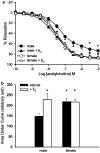
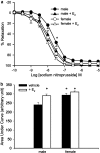
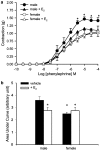
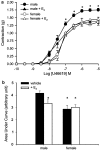
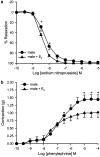
Similar articles
-
Circulating sex hormones modulate vascular contractions and acute response to 17β-estradiol in rat mesenteric arteries.Pharmacology. 2011;88(1-2):55-64. doi: 10.1159/000329426. Epub 2011 Jul 25. Pharmacology. 2011. PMID: 21791946
-
Contribution of K+ channels to relaxation induced by 17beta-estradiol but not by progesterone in isolated rat mesenteric artery rings.J Cardiovasc Pharmacol. 2003 Jan;41(1):4-13. doi: 10.1097/00005344-200301000-00002. J Cardiovasc Pharmacol. 2003. PMID: 12500016
-
Alterations in EDHF-mediated hyperpolarization and relaxation in mesenteric arteries of female rats in long-term deficiency of oestrogen and during oestrus cycle.Br J Pharmacol. 2001 Mar;132(5):1035-46. doi: 10.1038/sj.bjp.0703899. Br J Pharmacol. 2001. PMID: 11226134 Free PMC article.
-
Raloxifene relaxes rat intrarenal arteries by inhibiting Ca2+ influx.Am J Physiol Renal Physiol. 2005 Jul;289(1):F137-44. doi: 10.1152/ajprenal.00353.2004. Epub 2005 Feb 15. Am J Physiol Renal Physiol. 2005. PMID: 15713909
-
[Mechanisms underlying enhanced vasodilator responses to various vasodilator agents following endothelium removal in rat mesenteric resistance arteries].Yakugaku Zasshi. 2007 Apr;127(4):729-33. doi: 10.1248/yakushi.127.729. Yakugaku Zasshi. 2007. PMID: 17409704 Review. Japanese.
Cited by
-
Sex differences in mesenteric endothelial function of streptozotocin-induced diabetic rats: a shift in the relative importance of EDRFs.Am J Physiol Heart Circ Physiol. 2012 Nov 15;303(10):H1183-98. doi: 10.1152/ajpheart.00327.2012. Epub 2012 Sep 14. Am J Physiol Heart Circ Physiol. 2012. PMID: 22982780 Free PMC article.
-
Vasodilation in response to the GPR30 agonist G-1 is not different from estradiol in the mRen2.Lewis female rat.J Cardiovasc Pharmacol. 2011 May;57(5):598-603. doi: 10.1097/FJC.0b013e3182135f1c. J Cardiovasc Pharmacol. 2011. PMID: 21326105 Free PMC article.
-
Differential ligand binding affinities of human estrogen receptor-α isoforms.PLoS One. 2013 Apr 30;8(4):e63199. doi: 10.1371/journal.pone.0063199. Print 2013. PLoS One. 2013. PMID: 23646196 Free PMC article.
-
Bazedoxifene-induced vasodilation and inhibition of vasoconstriction is significantly greater than estradiol.Menopause. 2019 Feb;26(2):172-181. doi: 10.1097/GME.0000000000001195. Menopause. 2019. PMID: 30130290 Free PMC article.
-
Sexual dimorphism of cardiovascular ischemia susceptibility is mediated by heme oxygenase.Oxid Med Cell Longev. 2013;2013:521563. doi: 10.1155/2013/521563. Epub 2013 Sep 17. Oxid Med Cell Longev. 2013. PMID: 24163720 Free PMC article.
References
-
- AKISHITA M., KOZAKI K., ETO M., YOSHIZUMI M., ISHIKAWA M., TOBA K., ORIMO H., OUCHI Y. Estrogen attenuates endothelin-1 production by bovine endothelial cells via estrogen receptor. Biochem. Biophys. Res. Commun. 1998;251:17–21. - PubMed
-
- ASANO K., MARUYAMA S., USUI T., FUJIMOTO N. Regulation of estrongen receptor alpha and beta expression by testosterone in the rat prostate gland. Endocr. J. 2003;50:281–287. - PubMed
-
- BAUERSACHS J., POPP R., HECKER M., SAUER E., FLEMING I., BUSSE R. Nitric oxide attenuates the release of endothelium-derived hyperpolarizing factor. Circulation. 1996;94:3341–3347. - PubMed
-
- CREWS J.K., KHALIL R.A. Gender-specific inhibition of Ca2+ entry mechanisms of arterial vasoconstriction by sex hormones. Clin. Exp. Pharmacol. Physiol. 1999;26:707–715. - PubMed
Publication types
MeSH terms
Substances
LinkOut - more resources
Full Text Sources

